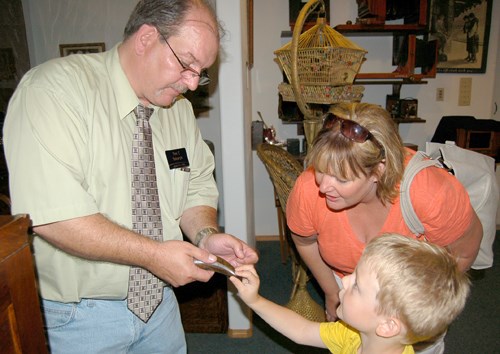Scotty the T-rex received a grand welcoming to Weyburn at the Soo Line Historical Museum on August 18. The Museum held a reception to acknowledge the arrival of the travelling exhibit from the Royal Saskatchewan Museum (RSM).
Dignitaries Mayor Debra Button and Souris-Moose Mountain MP Ed Komarnicki gave greetings at the event which was attended by young and old - 65 million years old, in fact.
"I am pleased to welcome the most unusual guest to Weyburn - Scotty the T-rex," said Button.
Button also announced that the City would provide an additional $3,000 in funding to the Museum, annually.
Head palaeontologist for RSM Tim Tokaryk spoke about the discovery of Scotty and the on-going efforts to unearth its fossilized body from the ground.
Tokaryk explained that a tailbone belonging to Scotty was found in the Frenchman River Valley, southeast of Eastend, in 1991. Due to a lack of resources however, the area would not be excavated again until 1994 when Scotty's skull was discovered by Tokaryk.
"Ninety-nine percent of what we find is fragments," said Tokaryk. "After 10 years of working in the quarry we have about 65 percent of the animal. We are still extracting the fossil from the rock."
Much of the dinosaur's spine is still in the quarry. Approximately 40 tonnes of dirt has been moved for Scotty's excavation.
"The problem is - how do you get a 40-foot animal out of the ground?" queried Tokaryk.
Tokaryk said that much of what palaeontologists know about the Tyrannosaurus rex came from Scotty, including his "slice and swallow" chewing mechanism. He admitted that the name for the T-rex came from a bottle of scotch that was present at the 1994 excavation.
Tokaryk said palaeontologists are still digging up dinosaurs in Saskatchewan. Two months ago, a new type of dinosaur, the Mojoceratops, was discovered, first in Alberta, then on the shores of Lake Diefenbaker. Triceratops and Thescelosaurus have also been found in the province, along with 18 species of pre-historic plants and 12 species of extinct vertebrate animals.
Tokaryk said he has also done excavating in the Oxbow and Avonlea areas.
The travelling exhibit is a cast of the original T-rex skull. The original fossil is on permanent display at the T-rex Discovery Centre in Eastend.
Scotty will be at the Soo Line Historical Museum until November 30.




